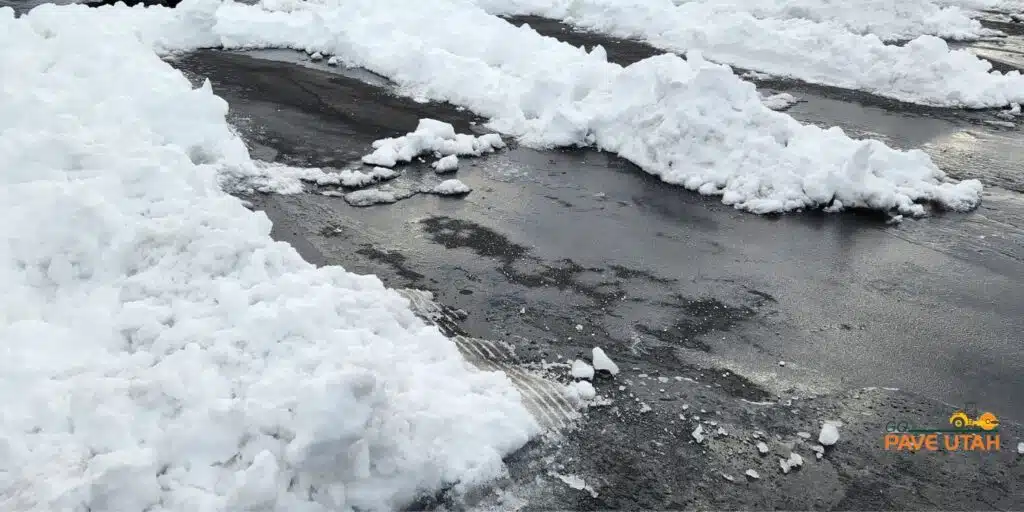
Roads, driveways, and parking lots bear the brunt of winter's icy grip, often succumbing to the challenges posed by plummeting temperatures and the ceaseless dance between freezing and thawing. The need for asphalt repair in winter becomes a pivotal narrative in the maintenance of our paved spaces and Go Pave Utah has you covered.
Asphalt, that stalwart ally of our daily commutes and parked vehicles, undergoes a metamorphosis when winter descends. The freeze-thaw cycle, a relentless routine of contraction and expansion, puts immense strain on the asphalt's molecular structure. This dance of temperature extremes is a formidable adversary, creating a battleground where even the most robust asphalt surfaces find themselves vulnerable.
The primary antagonist in this winter tale is the ubiquitous freeze-thaw cycle. As temperatures oscillate between freezing and thawing, water seeps into the microscopic crevices within the asphalt. When this water freezes, it expands, exerting pressure on the asphalt from within. Subsequent thawing reverts the water to its liquid state, but the damage is already done. The repeated onslaught of freezing and thawing weakens the asphalt, causing cracks, potholes, and a general deterioration of its structural integrity.
Cracks begin to emerge like fault lines on a winter landscape. They are not merely cosmetic blemishes but conduits for water infiltration, exacerbating the damage beneath the surface. Left unchecked, these seemingly minor cracks evolve into chasms, giving rise to the potholes that are the bane of motorists and pedestrians alike.
The necessity of asphalt repair in winter becomes apparent when we acknowledge the perils of neglect. A small crack, dismissed as a minor inconvenience, becomes a gateway for winter's icy fingers to delve into the heart of the asphalt structure. The freeze-thaw cycle exploits these vulnerabilities, magnifying the damage and transforming a seemingly minor issue into a significant concern.
The repair process in winter, however, is a delicate dance between necessity and environmental constraints. Traditional asphalt repair methods may encounter impediments when faced with cold temperatures and the potential for precipitation. The efficacy of hot mix asphalt, a staple in warmer seasons, diminishes when applied in colder climates. The challenge, therefore, lies in adapting repair techniques to the specific demands of winter.
One alternative that gains prominence in the winter arsenal is the use of cold mix asphalt. Unlike its hot counterpart, cold mix asphalt does not require high temperatures for application. It remains pliable even in colder conditions, making it a viable option for addressing winter-induced asphalt woes. This adaptability to lower temperatures ensures that repairs can be undertaken even when the mercury dips, providing a crucial lifeline for asphalt in need.
The winter repair narrative extends beyond mere patching of visible cracks. It delves into the realm of preventative measures, a strategic effort to fortify the asphalt against the impending challenges of the season. Sealcoating, a protective shield applied to the asphalt surface, becomes a formidable ally. It serves as a barrier against water infiltration, mitigating the impact of the freeze-thaw cycle and preserving the integrity of the asphalt.
The importance of timely asphalt repair in winter transcends the realm of individual driveways or parking lots. It intersects with the broader tapestry of infrastructure that crisscrosses our cities and towns. Pothole-riddled roads pose not just a logistical challenge but a safety hazard. They become the testing ground for the resilience of our vehicles, the patience of commuters, and the efficiency of municipal maintenance efforts.
The fractures in the asphalt, though subtle at first, have the potential to widen into chasms of inconvenience and hazard. Asphalt repair in winter becomes more than a reactive measure; it transforms into a strategic investment in the longevity and safety of our paved landscapes. It's a testament to our capacity to adapt, to innovate, and to ensure that the asphalt beneath our wheels remains a resilient ally in the face of winter's challenges. If you notice asphalt cracks or other damage at your home or business, the sooner you act the better. We work year-round for your safety. Get in touch with Go Pave Utah today to schedule your asphalt repair or schedule a consultation.
